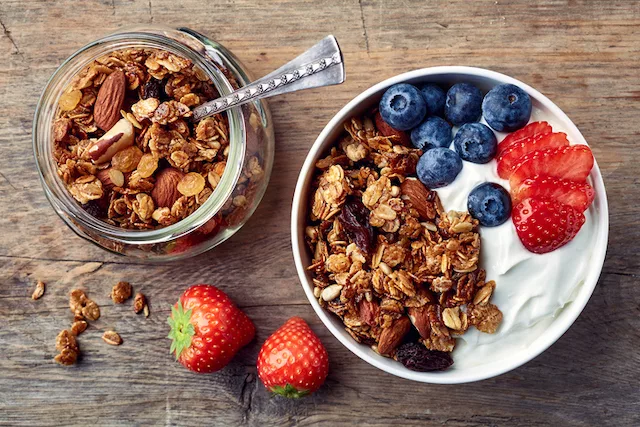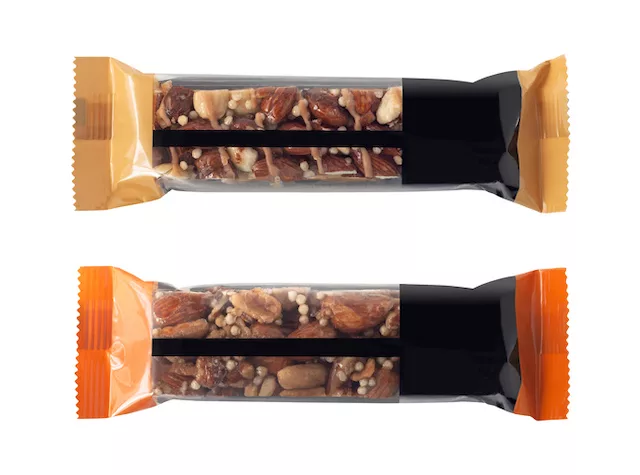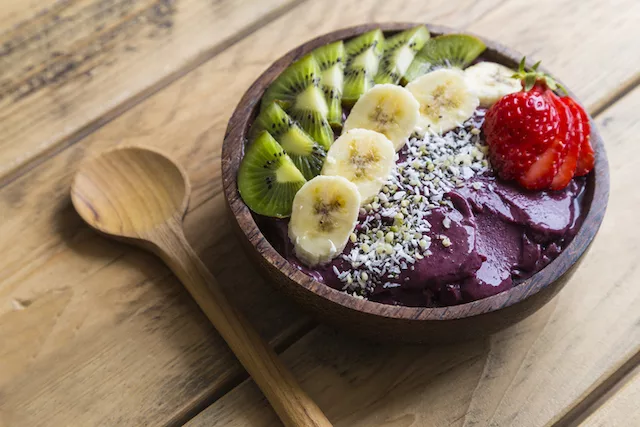We explore the truth about ‘healthy’ foods that are in fact no so healthy. Learn which seemingly good-for-you dishes may not be as nutritious as they appear, and discover clever ways to transform them into actual healthy alternatives. Say goodbye to fad diets and embrace evidence-based nutrition for a sustainable and nourishing lifestyle.
Foods you consider healthy may not be as healthy as you think. Are smoothies healthy? What about granola and yogurt? That depends on what’s in it…
Supermarket aisles are littered with misguided food labels and false claims about the health quality of their products. Labels such as ‘all-natural’ and ‘multi-grain’ do not provide a complete picture of what is actually in the product. In addition, there is no science behind health claim labels and ones perpetuated by fad diets. Therefore, improving your health means relying on evidence-based nutrition.
We’ll delve more into examples of unhealthy healthy foods and take a look at how to improve the nutritional value of some popular healthy dishes.

The Misconception of Healthy Foods
Navigating food aisles can be tricky. We buy brands and foods based on how healthy we think they are. As we become more reliant on information from non-evidenced based sources such as websites, friends, and family, it’s become more difficult to discern the truth behind food claims. This opens up opportunities for nutrition misinformation.
We believe products with health claims are healthier than they really are preventing us from making healthier choices. Low sodium, cholesterol free, fat-free, and sugar-free are common health claims.
Only the ingredients list will tell you if your choices are healthy. It can reveal hidden sugars, preservatives, added fats, vegetable oils, and other unhealthy ingredients.
Not-So-Healthy Foods in Disguise
Companies work hard to disguise their unhealthy foods through health claims on food labels. This makes it hard to distinguish if a specific food product is actually healthy. Here we go over popular foods we mistake as healthy and explain why they may not be as nutritious for us as we think.
Protein Bars: A Yummy Snack to Fuel Your Fitness Goals
Protein bars are a popular snack disguised as healthy. They are everywhere and come in a wide range of flavors. Take a closer look and you’ll find they contain heaping amounts of sugar, artificial flavoring, and saturated oils.
Even if you find them in health food stores they “may as well be located next to the candy bar section,” says Megan Darlington, a registered dietician at Test Prep Insight. “Many brands these days claim their protein bars are healthy, the truth is many of them are not.”

Store-bought Smoothies: A Tasty Shortcut to Your Daily Nutrients
Store-bought smoothies do not have the same health benefits as homemade ones. Many of these commercial smoothies are packed with sugar from sources like honey, fruit extracts and juices, and agave. Additionally, some recipes include calorie-boosting ingredients like peanut butter, seeds and coconut shavings. This turns an otherwise nutritious smoothie drink into a high-calorie, sugary, fatty meal.
Granola: Fuel Your Day with Nutty Goodness
Granola has been a popular “healthy” on-the-go snack, marketed as a fiber-rich option with whole grains and protein. However, the reality is quite different, as certain varieties are loaded with sugar, saturated fat, and excessive calories. A single cup of granola can contain up to 600 calories and nearly 4 teaspoons of sugar per serving. This is more than half of the daily maximum recommended by the American Heart Association.
Yogurt: A Burst of Taste in Every Spoonful
Yogurt can be a great source of protein and a healthy snack if it’s plain. Often the fruit-flavored varieties can contain a surprising amount of sugar for a single serving. For example, a 6.0-ounce serving of Yoplait’s Strawberry Low Fat flavored yogurt contains 13 grams of added sugar. Other flavor varieties with chocolate shavings and whipped versions contain even more.
Acai Bowls: Tropical Berrylicious Bliss in a Bowl

Acai bowls have been the most hyped-up food in the health industry. Blended acai berries are full of antioxidants, vitamins, and minerals. However, the healthiness of an acai bowl depends on the toppings and the acai blend. So, beware of the toppings.
Most commercially sold acai bowls are packed full of calories and sugar. They are usually blended with juices which bump up the added sugars. When you add sugary toppings like granola, coconut shavings, additional fruit, and honey it goes from a healthy treat to a meal loaded with calories, fat, and sugar.
Transforming Unhealthy to Healthy
Eating healthy doesn’t mean giving up our favorite foods. Instead, we can explore simple modifications to turn our beloved unhealthy dishes into healthier alternatives. By eliminating unhealthy fats and reducing extra sugars, we can still enjoy satisfying meals without compromising our health and diet goals. Let’s discover how to get our food fix the healthier way!
Pizza
America’s favorite dish is usually laden with greasy processed meats such as sausage, pepperoni, and salami. Make it healthier by swapping them out for chicken or turkey sausage.
Or simply go for a vegetarian pizza and go crazy on vegetable toppings like arugula, artichoke, bell peppers, onions and mushrooms. Eating a large variety of vegetables is not only better for your health but the diversity of plants also helps with improving your gut microbiome. And what better way to do this than adding it to pizza?
Pasta Dishes
Eat healthier carbs by swapping out your noodles for whole wheat noodles. Other noodle alternatives include zucchini, butternut squash, and edamame. Add a lean protein source like chicken, shrimp, or salmon, one of the healthiest fish to eat, and top it off with vegetables for a complete meal.
Granola Bars
Granola’s convenience and crunch make it a popular snack. Here’s how you can sidestep the calories and the sugars:
Look for whole oats as the first ingredients followed by other whole foods such as dried fruit, nuts, and seeds. Aim for at least 4 grams of fiber and limit the sugar per servings to less than 10 grams for a healthier snack.
To make granola even healthier, look for options that are high in protein. Ingredients that contribute to this include soy protein, peanuts, quinoa and nut butter.
Acai Bowl
The best way to make a healthier acai bowl and take advantage of its antioxidants and nutrition is to make your own at home. Blend in greens like kale, spinach, or arugula to boost antioxidants. Bump up the protein content to stay full longer by adding your favorite protein powder or collagen powder, and seeds and nuts. Other options include chia seeds, hemp seeds, almonds, walnuts, and cashews. To control the sugar and calorie intake, limit the number of sugary toppings and the portion size.
The Importance of Evidence-Based Nutrition
Following evidence-based nutrition guidelines can help you determine the healthiness of foods in a sea of false health claims. “Evidence-based guidelines are based on the best available scientific evidence,” says Johna Burdeos a seasoned registered dietitian with 20 years of experience in clinical nutrition. “This means that they are more likely to be effective in improving your health than guidelines that are not based on evidence.”
New fad diets come out every year. Even though they are not based on scientific data and have no evidence of their effectiveness, it hasn’t stopped the enormous growth of the diet industry in the US. In 2020, the diet industry in the US was valued at over $70 billion.
Registered nutritionist and dietician Krutika Nanavati at Clinicspots has this to say about people following fad diets, it can have “potentially dangerous consequences for their health, especially if the diet is not properly designed to meet their individual needs.” She adds that fad diets without scientific basis, “do not provide the essential nutrients needed for optimal health.”
If you’re looking for personalized nutrition guidance, she suggests working with a qualified professional such as a registered dietician or nutritionist. They “will be able to assess your individual needs and provide evidence-based recommendations that can help you reach your goals.”
And as far as interpreting those health claims on food packages? “They are also able to provide education on reading food labels so that you are able to make informed decisions about the foods you are consuming,” she adds.
Nourishing Your Body for the Long Run
Nutrition is a lifelong journey and not a quick-fix solution. Without evidence-based information, we can be misled by health claims which make it challenging to gauge the quality of our foods.
This is why it’s important to avoid fad diets and food trends and instead adopt an evidence-based approach to eating. Johna Burdeos says, “Evidence-based guidelines are updated regularly. They take into account the latest research findings and are constantly being improved.” Not only that but “evidence-based guidelines are tailored to specific populations.”
Working with a trained professional such as a registered dietician can be your best resource for learning how to create sustainable eating habits that work for you.
As Megan Darlington , RD, says, “It is important to seek nutrition and dietary guidance from qualified professionals because they will not only help you avoid common pitfalls, but they will also be able to provide insights and tips based on your specific health conditions, eating behaviors, food intolerances and allergies.”
The Takeaway?
Manufacturers employ food labels and health claims to magnify the advantages of their products. However, you can avoid these misleading food labels by adhering to evidence-based nutrition and dietary guidelines.
Furthermore, seeking the guidance of a certified registered dietitian can assist you in creating a personalized nutrition plan tailored to your specific needs and objectives. They can also aid you in deciphering food labels, enabling you to make well-informed choices when deciding between health claims on unhealthy foods and nutritious alternatives.
Through making minor adjustments to our diets, we have the power to convert our favorite unhealthy foods into healthier alternatives, leading to a life that is both vibrant and more wholesome.
